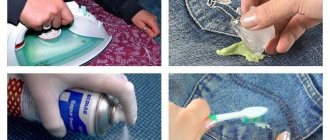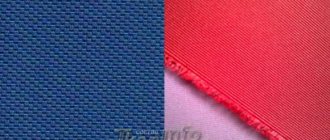During wear or improper care, items can stretch, losing their original shape.
In some cases, it is quite possible to return clothes to the desired parameters if you use simple methods of influence - washing and drying.
Let's figure out how to wash a thing so that it shrinks - at what temperature of water, how to do it to shrink cotton, synthetics, denim and other fabrics?
Let's figure out how to make clothes made of cotton, synthetics or denim shrink
As a rule, we can’t stand it when purchased new clothes fit like a glove when we try them on, fit both in length and width, but after the first wash they jump up by two or three centimeters, so that the item can no longer be worn. This happens especially often with cotton products. But there are situations on the contrary, when it is necessary to shrink the clothes a little, to “conjure” them so that they shrink. How can you downsize cotton, denim or polyester textiles to get your favorite clothes that fit perfectly?
Universal method
This method can be used for both cotton clothing and other popular fabrics. It is characterized by variable temperature.
For controlled shrinkage, use only clean clothing - before downsizing, wash clothing to remove any blood, juice or dirt according to manufacturer's recommendations. Pour the hottest possible water into the pre-prepared washbasin, almost boiling water is acceptable. Wait for the water to cool completely, then take it and squeeze it out a little. Now pour enough cold water into the bowl so that there is sure to be ice at the bottom. The product is again completely immersed in cold water for 15-30 minutes. After the time has passed, take them out, squeeze them a little to get rid of excess moisture, place them on a clean, dry towel and smooth out the folds. Let the fabric dry completely.
This method allows you to wash clothes in such a way that they become several values smaller. It is not suitable for the wardrobe for clothes made of thin and expensive fabric (dresses, expensive shirts and trousers), as well as for things that are inconvenient to soak in a container of water.
Proper washing strategy
WERAYUTH TESSRIMUANG/GETTY IMAGES
To keep your clothes looking like new, you need to choose the appropriate washing mode for them. The most important thing is to wash things so as not to damage them. In most cases, the art of proper washing involves preventing any potential shrinkage of clothing. After all, shrinkage of clothing items is one of the most common consequences of improper washing.
But sometimes there are exceptions: when going down a clothing size is exactly what you want to achieve.
see also
Big wash: how often should you wash clothes
? This may be necessary, for example:
- if you accidentally purchased clothes that didn’t fit in an online store or grabbed the latest branded item on sale that had long been the ultimate dream of yours, only it turned out to be a size or two too big;
- Or perhaps you've recently lost weight, but you don't have the desire to spend money on creating a whole new wardrobe.
You may have the idea to slightly shrink something that is too big by shrinking the fabric. This can be done by washing the clothes in hot water and drying them in a dryer at high temperatures, and also steaming them with a hot iron.
However, before you try to downsize a garment, it's important to understand why and how it shrinks, otherwise you could accidentally shrink your favorite T-shirt down to doll size, ruin the soft and bouncy texture of your sweater, and end up with a warped and strange-looking item whose sole purpose - to be a wuss.
Advice on fiber composition and proper laundering comes from one of the nation's leading laundry experts, Mary Gagliardi, aka "Dr. Laundry," a staff scientist and cleaning expert at Clorox, a global manufacturer of consumer detergents and cleaning products. The expert tells you everything you need to know about how to properly and safely shrink clothes made from different fibers.
How to dry acrylic items correctly
Proper drying of acrylic products is of no small importance for preserving the shape, size and color of clothing. To do this, any washed item is laid out horizontally on the grid surface of the clothes dryer or any other free horizontal surface. If it is a long scarf, you can fold it 2-4 times so that it fits in the designated space and does not hang vertically.
Important! Drying acrylic products in a vertical position, on ropes, heating radiators and in the sun is prohibited!
The tips given in the article are not complicated, but require mandatory adherence. Proper care of acrylic clothing will keep it in its original form and always look bright, stylish and impeccable.
5/5 — (1 vote)
Fiber type
textileschool.com
According to Mary Gagliardi, fiber type has a big impact on potential shrinkage.
- Fibers that absorb moisture easily, such as cotton and wool, are more prone to shrinkage.
- On the other hand, synthetics are hydrophobic (repel water) and are much less prone to shrinkage.
see also
How to best care for sportswear
Fiber tension
woodiesclothing.com
Another factor that can contribute to shrinkage is the degree of tension in the yarn fibers when the fabric is woven or knitted. Fiber that is highly stretched during fabric making will shrink in size when wet unless a special finish is applied during the manufacturing process to prevent this effect. In addition, how tightly the fabric is stretched during processing will later be reflected in shrinkage. As with yarn, fabric that is under tension during production will relax when wet. This process is called relaxation shrinkage, Gagliardi says.
During production, a finish can be applied to the fabric to reduce the effects of tension. In general, if a garment has any relaxation shrinkage, you will see most of it the first time you wash it. In other words, if clothes shrink a lot after washing, this means that the fabric used to sew them was not subjected to special anti-shrink treatment during production.
see also
How to keep clothes looking presentable after washing
When does the wool “shrink”?
A material such as wool, due to its naturalness and natural characteristics, can easily be modified under the influence of various sources. First of all, woolen items shrink when washed at high temperatures . Natural hairs curl, compact and “fall off”, which makes the product warmer, but significantly reduces its size.
Important! Items containing both real wool and artificial fibers can behave completely differently. Some things containing synthetics do not shrink at all, some only stretch. Therefore, for products with a mixed composition, methods typical for natural woolen items may not always be suitable.
Quality of clothes
www.liveabout.com
The higher the quality of the clothing, the less likely it is to shrink. Special finishes and manufacturing technologies that prevent shrinkage are more often used by higher-end manufacturers who care about product quality. Because most people don't want their clothes to shrink, Gagliardi notes. Customers want to be able to wash their clothes over and over again and keep wearing them, and for them to continue to look the same as when they bought them.
How and at what temperature should you wash cotton in a washing machine?
When automatically washing cotton, to prevent it from shrinking, you must follow the following rules.
- Study the recommendations indicated on the product tag.
- Inspect the material for stains and, if any, remove them before washing. To remove stains from white fabrics, you can use mild oxygen bleaches without chlorine.
- Sort items by color, wash white items separately.
- Sort clothes according to degree of soiling, and wash items that simply need to be refreshed on a gentle cycle.
- Place clothes or bedding in the drum after turning them inside out and fastening all zippers and buttons.
- Place small items in a special bag or an old pillowcase before loading the laundry into the machine.
- For dense fabrics, set a mode in which the water temperature does not exceed 60 degrees.
- Delicate materials should be washed at 40 degrees.
- For colored items, use detergents containing enzymes to prevent shedding.
- When using dry powders, install an additional rinse.
- Use a gentle spin and turn off the automatic drying function.
Advice
In order for cotton items to be ironed better, they should be hung out to dry immediately after the wash cycle ends, and not left in the drum for a long time. In addition, the material will need to be carefully straightened - this will help eliminate large creases and folds.
How to shrink clothes
home.howstuffworks.com
Regardless of the type of clothing - cotton or denim shirts, hoodies, trousers or jeans, or the fabric - from viscose to 100 percent cotton, the most common process that causes potential shrinkage of clothing is machine washing in hot water and machine drying on high heat. heating
- The hotter the water and the higher the temperature in the dryer, the more the shrinkage rate of any item of clothing that has not been treated during manufacture with special means to prevent shrinkage or shrinkage of the fibers will increase.
This is just one of the reasons why it is important to use water at the optimal temperature when washing. However, higher dryer temperatures can not only cause your clothes to shrink, but also promote fading and damage to the surface of the fabric, usually in the form of creases and tears.
Unfortunately, when it comes to intentionally shrinking clothing, you won't always be successful. For example, if you buy a pair of pants that are too big for you and hope to shrink them a size or two, they may end up getting misshapen. Although washing and drying your trousers at high temperatures can shorten them in length and reduce the waistband, their width may not change at all. This is due to the fact that the cross thread (weft), which runs across the width of the fabric, is much less prone to shrinkage than the warp thread, which runs along the entire length of the fabric. Garments shrink along the length and at the waist because these pieces are usually cut lengthwise along the fabric, the expert says.
see also
How to wash a wool sweater (without ruining it)
To make jeans fit
Remember that shrunken jeans will become shorter. If you need to shrink your jeans, wash them at maximum temperature in the washing machine using the highest speed setting. With this exposure, the fabric fades a little. We do not recommend shrinking different colored jeans at the same time.
Having figured out what water to wash in, let’s look at the drying options:
- Take advantage of the built-in tumble dryer.
- Place the jeans on a hot surface.
- Hang to dry in front of an open oven.
How to shrink cotton
WERAYUTH TESSRIMUANG/GETTY IMAGES
Cotton items shrink best . Cotton is a machine washable fiber that is more likely to shrink under the standard process of washing on a hot cycle followed by a high heat cycle in the dryer. However, finishes applied during production can limit shrinkage, Gagliardi says. The best you can do is try to take advantage of the relaxation shrinkage effect - cotton fibers and yarns have some difficulty getting wet. But even this process has its limits.
Relaxation shrinkage is usually reversed. Remember: when you put on your pants immediately after washing, the belt fits snugly around your waist. But when some time passes, it stretches again - the tension is restored. This effect is clearly visible in the example of jeans, which after washing fit tightly, and then become loose during wear. Tension is the stretching of the waist to the desired size. The pattern pieces for the waistband and legs are cut in the warp (length of the fabric) direction, which tends to weaken more than the weft (width) direction.
So while some items become shorter when machine washed and dried, they do not become narrower. This means that the item can only be shrunk along the length, but in the width it will most likely remain wide or narrow minimally.
Blended fabrics
If any synthetic material is added to the composition of a cotton T-shirt, then the procedure for changing its size will change while maintaining the first stages. You can add boiling or steaming to washing in a washing machine, which exceeds 100 °C. A double boiler will increase the maximum possible temperature to 220 °C. The last steps must be carried out with caution and as a last resort, as there is a risk that this will completely damage the product.
You should use a mesh bag to protect your clothes in a top loading machine. For mixed fabrics, you need to choose a delicate wash with a short duration. Most washing machines have a low temperature setting, which is ideal in this case. Increased temperature can compress the tension of the threads, causing them to move closer to each other and the size of the item to decrease.
When washing, use a mild powder and avoid using chlorine bleach as it can damage the material. After washing, the product should be wrapped in a towel for several minutes and do not wring out. This will remove excess water from it and not damage the fabric structure.
Clothes should be air dried. An almost dried item can be placed in the dryer. Five minutes is enough to complete the shrinkage. Cold drying should be used at this stage. Once the product has been reduced to the desired size, it can be removed from the machine and used.
Another radical method of washing clothes to make them shrink is suitable for items made of cotton, linen and other fabrics, except synthetics and silk. It consists of alternating hot and cold water, into which the item is alternately immersed. To do this you need:
- Place the product in a container and fill it with boiling water, add fabric softener.
- Wring out the product.
- Prepare a bowl of water mixed with pieces of ice. Immerse the item of clothing in it and leave for 20 minutes.
- Squeeze it lightly and place it on a towel to dry.
How to shrink denim (denim)
thejeansblog.com
see also
How to remove price tag or label glue from clothes without damaging it
Denim, or denim , is the same as cotton, only made from coarser fibers and with a tighter weave. If you are going to shrink denim, you can wash and dry it in a washer and dryer. But not all denim fits reliably, especially in width, reminds a laundry expert.
There is one exception: Levi's Shrink-To-Fit 501 jeans, which are designed to change size in the wash. Jeans of this brand are specially purchased two sizes larger, then soaked, and after drying they acquire the desired size. When they are sewn, the manufacturing steps that would normally prevent or limit shrinkage are omitted, so these jeans will shrink completely afterwards. But even these jeans, if you buy them larger than the recommended size, will not shrink more than the manufacturer suggests.
Is it better to use hand or machine wash?
Washing by hand allows you to control not only the size of the item being reduced, but also better preserves the color of the material from which it is made. This is the reason why hand washing is more desirable.
For some fabrics that easily withstand mechanical stress, such as synthetics, it is better to shrink them using a washing machine. This will help maintain strength and be effective.
How to shrink polyester
stylecraze.com
Synthetic fibers such as polyester are much less prone to shrinkage because synthetics, unlike cotton, do not "relax" in the same way as natural fibers. Machine washing and drying may cause some lengthwise shrinkage, Gagliardi says, but there's no way to make an item shrink all the way to size. Moreover, washing and drying in hot water can damage synthetics, and the item will be irrevocably damaged.
see also
How to independently widen jeans and trousers at the waist (without needles and threads)
How to remove stains?
Minor surface contamination can be removed using:
- Soap solution . The composition is applied to the area of contamination and the fabric is lightly wiped with a soft sponge, after which it is washed in warm water;
- Salt. Cover the stain with salt and leave for 20-30 minutes. After cleaning, the item is washed and treated with rinse aid;
- Boric acid . To remove stains, use a 10% solution, which is applied in a small amount to the area of fabric at the site of contamination;
- Citric acid . The cleaning solution is prepared in proportions - 1 tsp. citric acid per 200 ml of water. Use the resulting mixture to wipe the contaminated area and rinse the item in cool water before washing.
The special structure of the fabric fibers makes it not prone to dirt penetration, making difficult-to-remove stains on this type of material a rare exception.











